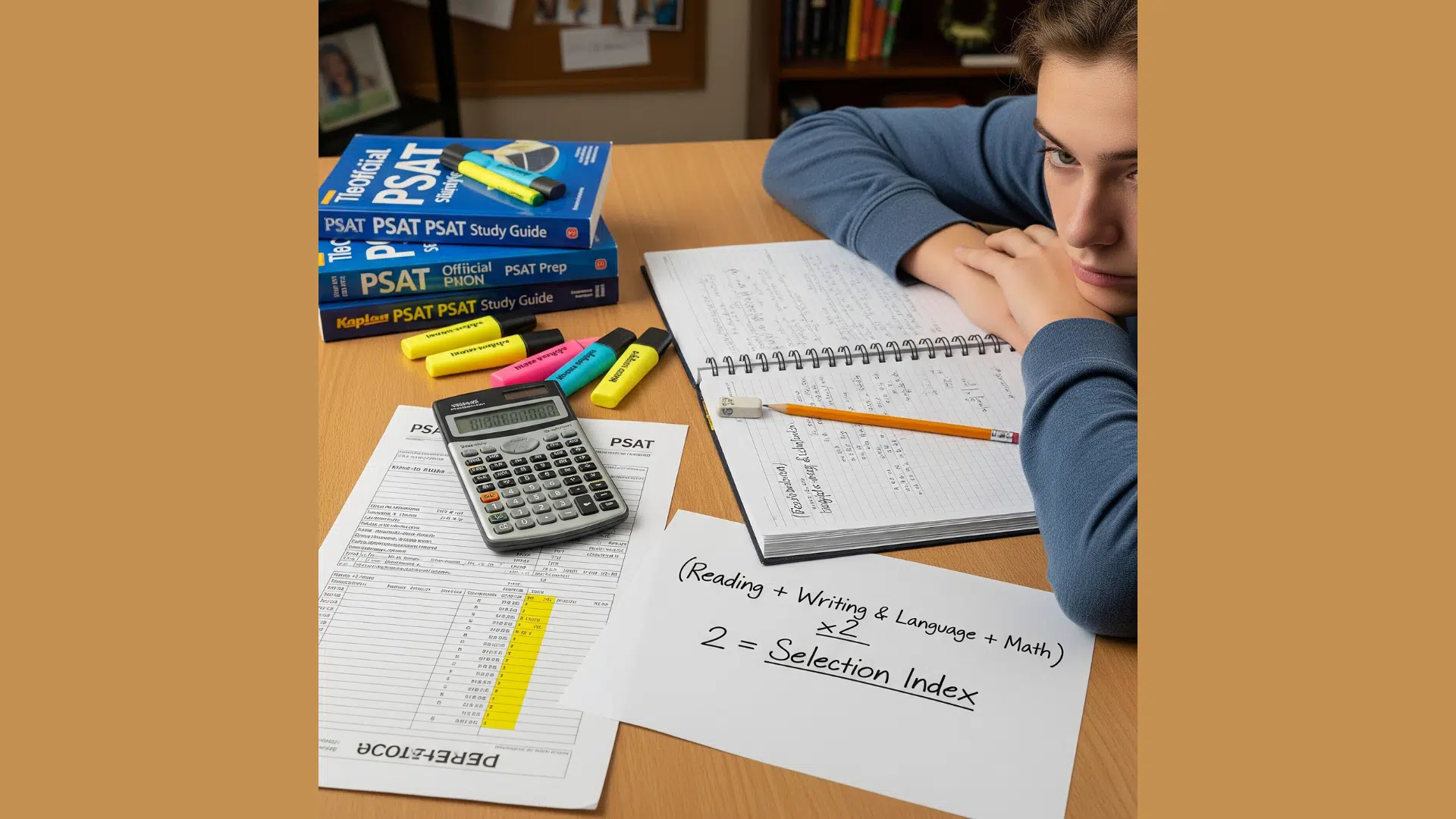Have you ever wondered why your PSAT score is not the only thing that matters for the National Merit Scholarship?
That is where the Selection Index (SI) comes in. The SI is a special score used by the National Merit Scholarship Corporation to decide who qualifies for awards like Commended Student and Semifinalist.
It is not the same as your total PSAT score; it is calculated in a different way. Each state also has its own cutoff, so a good SI in one state might not be enough in another.
Understanding your SI is the first step to aiming for National Merit recognition.
What is the NMSC Selection Index?
The NMSC Selection Index is a score used to help choose students for the National Merit Scholarship Program.
It is a special number made by adding together your PSAT Reading, Writing, and Math scores in a certain way.
The Selection Index helps decide if you will be named a Commended Student or a Semifinalist.
It is used by the National Merit Scholarship Corporation (NMSC) to compare students across the country.
This score is very important if you want to qualify for National Merit awards.
How is the Selection Index Calculated?

The Selection Index is not based on your overall PSAT score.
Instead, it uses your test scores from the Reading, Writing & Language, and Math sections.
Each of these scores ranges from 8 to 38.
Here is the simple formula:
(Reading + Writing & Language + Math) × 2 = Selection Index
You might also hear it explained another way:
Double your Reading and Writing scores, then add your Math score.
This is because the verbal section (Reading + Writing) is more important in the National Merit process, so it is counted twice as much as Math.
Step-by-Step Calculation Example
Let us walk through an easy example of how to calculate your Selection Index (SI).
- Locate your test scores for:
Reading
Writing & Language
Math
(Remember, these are individual test scores from 8–38, not your scaled section scores.) - Add all three test scores together:
Reading + Writing + Math = Total - Multiply that total by 2:
Total × 2 = Your Selection Index
Example:
Let’s say your test scores are:
Reading = 34
Writing & Language = 35
Math = 36Step 1: Add the test scores
34 + 35 + 36 = 105Step 2: Multiply by 2
105 × 2 = 210Your PSAT Selection Index = 210
Why it Matters: Commended vs. Semifinalist
The Selection Index (SI) is very important because it helps decide if you qualify for National Merit honors.
There are two main levels: Commended Student and Semifinalist. Your SI score must be high enough to reach one of these levels.
The cutoff for Commended is the same across the country, but the Semifinalist cutoff is different in each state.
Students with the highest scores in their state become Semifinalists and may move on to become Finalists or win scholarships.
Here is a simple table to show the difference:
| Feature | Commended Student | Semifinalist |
|---|---|---|
| Cutoff Score | Same across the U.S. (around 207–210) | Varies by state (about 208–223) |
| Number of Students | About 34,000 | About 16,000 |
| Scholarship | No, but looks good on college apps | Can qualify for scholarships |
| Next Steps | No further steps | Must submit an application, essay, and SAT/ACT scores |
State Cutoffs & Trends

The Selection Index (SI) cutoff score needed to become a National Merit Semifinalist is different in every state.
That is because the National Merit Scholarship Corporation (NMSC) aims to recognize the top 1% of PSAT/NMSQT test takers in each state, ensuring equal representation based on where students live and test.
1. How Cutoffs Work:
- Each U.S. state and territory has its own Selection Index cutoff determined annually by NMSC.
- Only the top scorers in each state (about the top 1%) qualify as Semifinalists.
- These cutoff scores change slightly each year based on how students perform nationally and within each individual state.
2. Typical Score Range:
- In most years, state Semifinalist cutoffs range from 208 to 223.
- The average cutoff across all states usually falls around 212 to 218, but there is no official average published by NMSC.
- You can use 216 as a general benchmark if you are unsure where your state usually falls.
3. High-Cutoff States (More Competitive):
- New Jersey, Massachusetts, Maryland, Virginia, California, and District of Columbia typically have the highest cutoffs, often between 220 and 223.
4. Lower-Cutoff States (Less Competitive):
- States like Montana, Wyoming, West Virginia, and North Dakota usually have lower cutoffs, sometimes between 208 and 212.
Preparing to Maximize Your SI
The Reading and Writing & Language (ERW) sections carry more weight in the calculation, so emphasizing your ERW prep can make a big difference.
Here are some simple ways to improve:
- Use PSAT Equating Tables: These tables show how your raw scores translate to the scaled scores, so you can understand where you need to improve.
- Practice Under Timed Conditions: Doing practice tests in a timed setting helps you get used to the pace of the test. It also helps you manage your time better.
- Review Weak Areas: After each practice test, look at which sections or types of questions you struggled with, and spend more time improving those areas.
What Comes Next After PSAT?
If you score high enough to become a Semifinalist, there are a few more steps to complete before you can win a National Merit Scholarship.
First, you must send a confirming SAT or ACT score.
This score needs to be close to or higher than your PSAT Selection Index.
It shows that your PSAT score was not just a one-time thing.
Next, you will need to complete an application.
This includes:
- Your high school transcript (grades),
- A short essay, and
- A recommendation from your school.
Out of about 15,000 Finalists, around 7,500 students receive scholarships.
Conclusion
Understanding the NMSC Selection Index is a big step if you want to qualify for the National Merit Scholarship.
It is not just about your total PSAT score, it is about how your test section scores add up using the SI formula.
By focusing more on Reading and Writing, practicing under test conditions, and aiming above your state’s cutoff, you can improve your chances.
If you become a Semifinalist, be ready with your SAT/ACT score and the application.
A little planning now can lead to great rewards later!












